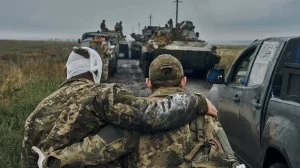The Islamic State’s Khurasan Province (ISKP) has drastically expanded its propaganda apparatus in recent months, releasing a steady flow of online print, audio, and video content. ISKP operates in Afghanistan and Pakistan, but it is making a greater push to build support, fundraise, and recruit from Central Asia, particularly Uzbekistan and Tajikistan. This outreach campaign runs through ISKP’s Al-Azaim Foundation for Media Production which has formed Uzbek and Tajik language wings. ISKP primarily uses the Telegram messaging application to build its web of discussion channels, supporting propaganda creators, and its recruitment and fundraising operatives. To appeal to Central Asians, ISKP has ramped up its criticisms and threats toward regional governments such as those in Tashkent and Dushanbe. Further, the group has followed through on its hostile rhetoric, launching rocket attacks against Uzbekistan in April and Tajikistan in May.
This Insight explores ISKP’s Central Asia-targeted media campaign, how the group leverages technology, the prevalent themes and narratives used to reach the desired population segments, and techniques used to achieve these ends. To understand this phenomenon, we first outline the history of the Islamic Movement of Uzbekistan’s (IMU) move to join ISKP and how the IMU and its ideologues are important to Khurasan Province’s organisational lore. We then proceed to examine the narratives of Taliban atrocities committed against the IMU and their families in the magazines Dabiq and Voice of Hind. We conclude by arguing that ISKP continues to expand its Central Asia-facing propaganda content and how this increased focus on Uzbekistan and Tajikistan presents a continued threat to regional security.
IMU Pledges Allegiance to ISKP
The Islamic Movement of Uzbekistan (IMU) is a predominantly Uzbek insurgent group originally based in the mountains of eastern Tajikistan. Historically, the IMU has been allied with the Taliban and al-Qaeda. The IMU’s mission was to eventually topple the Uzbek government and implement an Islamic system according to its own vision. In August 2015, IMU leader, Usman Ghazi, released a video, swearing allegiance to the IS leader, Abu Bakr al-Baghdadi. This was preceded, days earlier, by another IMU video in which the group’s spiritual leader, Sheikh Muhammad Ali, likewise pledged to IS. Ghazi was angered by the Taliban withholding information about the death of their leader, Mullah Omar. Additionally, the IMU, in its official media releases, had complained about Central Asians “abandoning” Central Asia in its official statements. To the IMU leadership, the Islamic State offered a more ambitious vision of expanding its influence into the territories of Afghanistan’s northern neighbours.
The Taliban’s response to the IMU’s betrayal was fierce. The group hunted IMU forces, killing many in battle and executing others including Ghazi. However, the legacy of the IMU faction that pledged to IS continues to influence ISKP both operationally and ideologically. Per the militant aspect, there are likely some former IMU fighters still active within the ranks of ISKP. The son of former IMU leader Tahir Yuldash was reportedly even killed while fighting as a member of ISKP in 2019.
IMU Boosts ISKP’s Online Uzbek-Targeted Campaign
The IMU brought its robust Uzbek-language propaganda apparatus into ISKP’s network. The IMU’s propaganda network has allowed the ISKP to expand its audience into Uzbekistan and other Central Asian states. The IMU’s main propaganda platform is its website, founded around 2009. The website is a window into the group’s activities and alleged exploits of individual militants, mainly in Pakistan’s tribal areas, but also covered the fighting of IMU members alongside the Taliban in Afghanistan. Notably, confirmation of the deaths of IMU leaders Tohir Yuldash and his successor Usmon Odil came first from the website.
Since IMU declared its allegiance, there are now whole networks of ISKP social media pages and messaging application channels devoted to disseminating the audio statements of Uzbek ideologues such as Abduvali Mirzayev, Asadulloh Urganchiy, Juma Namangani, Tahir Yuldash, and more. The lectures of these figures continue to greatly influence and shape the thought of contemporary Uzbek ISKP propagandists, fighters, and supporters.
Uran Botobekov, an expert in Central Asian jihadism, says Abduvali Mirzayev’s religious popularity and famous khutba sermons helped fuel the development of radical Salafism in the Ferghana Valley during the 1990s. He was an imam in Andijan and his Khutbah sermons inspired the first generation of Uzbek jihadists. Mirzayev’s ideas inspired Juma Namangani, who fought in the Tajikistan Civil War and later relocated to Afghanistan where he co-founded the IMU along with Tahir Yuldash.
Asadulloh Urganchiy, perhaps the favourite of today’s Uzbek ISKP movement, was a prominent IMU religious authority and, as Botobekov describes him, “a theologically savvy ideologue of global jihadism.” He was long a proponent of toppling the Uzbek government and establishing an Islamic Caliphate. Urganchiy was known for his beautiful voice and divine talent for chanting Quranic texts and nasheeds which made him very popular amongst Central Asian jihadists. According to IMU audio messages circulated in ISKP channels on Telegram, the Taliban captured Urganchiy in November 2015 in Afghanistan’s Zabul province and reportedly executed him weeks later. However, Urganchiy’s words and ideas live on and ISKP actively archives and disseminates his sermons to supporters. He has entire Telegram channels dedicated to posting his speeches.
IMU and Dabiq Magazine

Symbolically, the IMU members that joined ISKP and were killed by the Taliban have had their memories exalted by the Khurasan branch and are framed as martyrs for the cause. The alleged massacres of IMU members and their families by the Taliban in Zabul feature prominently in the ISKP movement’s lore and telling of its history. IMU ideologues remain influential posthumously as their writings, audio lectures, and video statements are frequently shared throughout the Islamic State’s Uzbek language media and communications sphere.
The Islamic State’s grievances with the Taliban for killing IMU members date to the branch’s early years and were published by ISKP’s leader in IS central’s former premier international online print publication, Dabiq magazine. The magazine has been discontinued but is commonly shared on Telegram and is available on mainstream Internet archiving sites.
The Wali of ISKP was interviewed in IS’ Dabiq magazine in January 2016 and expressed his anger over “the treacherous, deviant, nationalist Taliban movement” killing and wounding of Uzbek fighters. He lambasted the group, alleging that the Taliban “increased in its tyranny and criminality by purposely killing their defenceless women and children, with the movement’s fighters executing them, sparing no one they could find.”
Regionally, the ISKP movement operates within a broader interlinked South Asian propaganda and communications ecosystem that includes official media outlets, aligned groups, and masses of supporters also linked to Islamic State branches in India (ISHP) and Pakistan (ISPP). One magazine series in particular, the pro-ISHP Voice of Hind which was circulated on Telegram and on archiving sites, had repeatedly impugned the Taliban for their attacks on Uzbek ISKP fighters and their non-combatant family members.
In Issue 2, the magazine states, “the Taliban has … killed the Mujahedeen from Uzbekistan in Zabul in order to please the filthy Rafidah,” accusing the Taliban of doing Pakistan’s bidding. This narrative was purveyed again in Issue 5 when ISHP said the Taliban attacked IMU members for kidnapping and killing Shiites as well as their pledge of allegiance to the Islamic State. In Issue 4, the Taliban are again scorned for attacking “the Islamic State, [killing] the Mujahedeen from Uzbekistan in Zabul province just because they had killed some filthy Rafidah” and thus, claims ISHP, the Taliban “allied with the Mushrikeen and showed enmity towards the Muwahedeen.”
Likewise, in an audio statement that was recently recirculated on Telegram throughout the online Uzbek IS sphere, Muhammed Ali Domla, an Uzbek ISKP jihadist and chief security officer of IMU, told of how the Taliban killed over 150 Uzbek fighters and their family members.
The Future of ISKP’s Uzbek Efforts
Since the Taliban regained power in Afghanistan, they have promised foreign governments that the country would not be used as a platform to launch terror attacks abroad. The new government faces deep economic problems and a dire humanitarian crisis, making it essential that they attract foreign investment and aid to ameliorate such woes. The Islamic Emirate of Afghanistan (IEA) has thus pressured its allies not to engage in international terrorism that would disrupt the Taliban’s foreign relations. Notably, Uzbekistan has emerged as the Taliban’s closest partner in Central Asia.
This creates an opportunity for the Islamic State as ostensibly the only available jihadist vehicle for attacking Uzbekistan that is free of Taliban-imposed restraints. To exploit this, ISKP has ramped up its hostile rhetoric targeting Tashkent and has fired rockets at Uzbekistan on at least one occasion.ISKP carries on the Uzbekistan-targeted bellicosity of the former IMU as well as its religious and ideological legacies. The Islamic State will continue to leverage the tales of massacres committed against the IMU members and innocent Uzbeks to exploit ethnic divides through its online media platforms. These potent narratives about the Taliban oppressing and committing violence against Uzbeks are designed to discredit the Taliban in the eyes of Afghan and Central Asian Islamists to establish a stark contrast between the IEA and ISKP.
ISKP is set to carry on producing propaganda in Uzbek and continue its efforts to broaden its appeal, recruit, and fundraise from Uzbek communities across Central Asia, throughout the broader region, and diaspora communities beyond. The Islamic State may very well launch future cross-border attacks, incite violence in Uzbekistan, and target Uzbek interests inside Afghanistan.
Source: gnet-research































